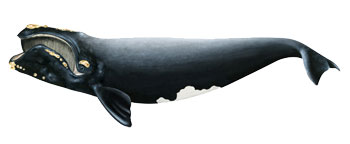Right Approaches for Right Whale Protection Considered
by Laurie Schreiber
We’re putting all our
eggs in two baskets”—
ropeless gar and
weak lines—“and we’re
not looking at smart buoys.
– Ron Smalowitz, Fishermen’s
Survival Fund
NEWPORT, R.I.—Sub-committees of the Atlantic Large Whale Take Reduction Team (ALWTRT) are studying the feasibility of ropeless fishing, and improved gear-marking and weak links, in the lobster fishery, as part of a push to reduce injury and mortality in the endangered North Atlantic right whale population.
Colleen Coogan, the marine mammal take reduction team coordinator for the Greater Atlantic Regional Fisheries Office, presented the latest report on ALWTRT activities to the New England Fishery Management Council (NEFMC) at its Dec. 6 meeting, in preparation for ALWTRT’s next meeting in March 2019.
One NEFMC member said it will be important to pay attention to the prospects for ropeless fishing, since it would affect not only fixed gear but boats in mobile gear fisheries. Mobile gear boats would have to carry transponders in order to receive signals from ropeless buoys, he said.

“Right now, we don’t know when or where they’re getting entangled.” – Ron Smolowitz
Ron Smolowitz, of the Fisheries Survival Fund, said he didn’t consider ropeless gear or weak lines to be smart approaches. Instead, he said, responding to entanglements in a timely manner could reduce injury and mortality. And establishing a system that better tracks where and how entanglements occur would be useful, he said.
“Right now, we don’t know when or where they’re getting entangled,” he said. Gear marking systems in place now haven’t proven worthwhile, he said. He suggested instead a “smart buoy” approach as a low-cost, established technology capable of tracking encounters and identifying the location of entanglement, which could guide responders and make disentanglements safer. In addition, disentanglement tools and techniques safer to humans and whales could be developed. “We’re putting all our eggs in two baskets”—ropeless gar and weak lines--“and we’re not looking at smart buoys,” he said.
Coogan said the ALWTRT’s preferred focus is not on weak line or ropeless fishing, but on reducing the numbers of vertical fishing lines in the water column. She continued, “I think making disentanglement a primary take reduction feature may have consequences that we regret later on,” adding that the approach builds into the process a substantial amount of risk to people performing disentanglements.
At its October meeting, the ALWTRT reviewed nine proposals to address the situation. According to the presentation, the general themes of the proposals included reducing risk using tools like new and modified seasonal closures; increasing visibility of rope to whales by, for example, using red line; continuation of the vertical/water column line reduction strategy; trap caps and reductions; ropeless technology in new closure areas or new fisheries and aquaculture, or in deep trap/pot fisheries; limits on new lines, especially in new closure areas, including aquaculture and experimental fisheries; remove/prevent new floating groundlines.
For reduced severity of entanglement, proposals included using ropes with a 1,700-pound breaking strength; capping rope diameter; using South Shore Sleeves; reducing surface systems rope configurations.
According to takepart.com, South Shore Sleeves were developed by the South Shore Lobstermen’s Association. They’re short lengths of hollowed-out cord that are spliced into buoy ropes at 40-foot intervals. They’re designed to be a “weak link” that will break when pulled by a whale.
The ASMFC has also
initiated a right whale
working group that’s
considering line
reduction measures.
– Coogan
Other proposals included improved monitoring and reporting; expansion of area covered by aerial and acoustic surveys; ropeless technology operational research; and Canadian collaboration across many of the investigations.
According to the latest estimate, there were likely no more than 411 North Atlantic right whales alive at the end of 2017. The calving interval has dropped to every 10 years; previously, it was every five years. It’s projected that, by 2030 there will only be the same number of females as there were in 1990.
“So 30 years of effort at recovery would be reversed if the current rate of decline continues,” Coogan said.
Among catalogued right whales, 85 percent have been entangled at least once in their lives every year. Whale exposure to human activities is increasing and whale distribution shifts in response to ecosystem changes. Ecosystem changes are also likely resulting in reduced prey and increased migration distances, which results in whales having to spend more energy to survive and having less energy to reproduce.

Since 1997, the fishing industry has implemented numerous measures to mitigate entanglements. That started with the implementation of weak links and gear marking requirements, followed by dynamic and seasonal closures designed to the respond to the presence of whales. In 2007, sinking groundline was implemented, along with further closures and expanded weak link requirements. Dynamic and seasonal closures were removed, since they proved not entirely successful, as well as difficult to administer and difficult for fishermen.
In 2014, the industry implemented a new rule aimed at reducing the number of vertical lines in the water, by having more traps on a line—called trawling up.
ALWTRT efforts in 2018 have been considerable, said Coogan. That included the establishment of the two sub-committees. The gear-marking sub-committee considers expanded gear-marking to be feasible, she said. There are concerns around expanded weak-link proposals for offshore use, given the dynamic ocean environment; and concerns about costs, she said.
The ropeless fishing subcommittee doesn’t consider it to be an available option as a short-term solution, she said.
The Atlantic State Marine Fisheries Commission has also initiated a right whale working group that’s considering line reduction measures, Coogan said.
